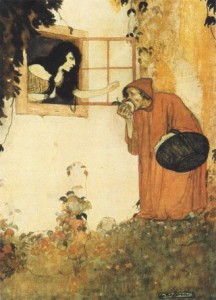“The Godfather Death” by the Brothers Grimm
Grimm, Jacob, Wilhelm Grimm, and Philip Pullman. Fairy Tales from the Brothers Grimm: A New English Version. New York: Viking, 2012. Print.
In this dark Fairy Tale, Death, the one of the main characters, does not discriminate. Instead, he ends everyone the same. Satire is evident in the relationship between the son and Godfather Death. Death gives the boy everything yet, the boy still crosses him more than once. Death warns the boy, who is older and a physician, about disobeying his call to Death and the physician keeps disobeying. He thinks to himself, Death could not possibly be so upset with him if he only disobeyed once for he was his Godson. Death, fair in nature, warned the physician he should never disobey again or feel the wrath of an icy death. However, as the King’s daughter becomes ill, he is smitten with her beauty and the promise of her hand in marriage and disobeys Death for the last time. In this scene, the physician is thinking selfishly. He is focused on his fortunes and, not remembering his covenant with Death. It was actually Death who gifted him with wealth. Death reminds the readers of The Godfather Death, a valuable moral: the fortunes in life and life can be taken away as swiftly as they were given.
Greed is a modern American flaw, because in our society we are never satisfied with what we do possess. We always want more. For example, obesity in America is a result of over-indulgence and greed. The New York Times published an article entitled, “Don’t Indulge. Be Happy.” The article compares and contrasts happiness and indulgence. This non-fiction article can be compared and contrasted to “The Godfather Death.” I would prompt a comparison of the two texts with the following questions.
1. Describe the similarities between the audience, modern American citizens, of “Don’t Indulge. Be Happy.” and the the son in “The Godfather Death?”
2. Identify the difference between the intentions of the moral message in both “The Godfather Death” and “Don’t Indulge. Be Happy” and explain how they are the same or different.
 “The Stubborn Child,” is another piece from the Grimm’s collection of Fairy Tales, except it is a piece of Flash Fiction standing alone as one paragraph. The Flash Fiction Fairy Tale, “The Stubborn Child,” reads below.
“The Stubborn Child,” is another piece from the Grimm’s collection of Fairy Tales, except it is a piece of Flash Fiction standing alone as one paragraph. The Flash Fiction Fairy Tale, “The Stubborn Child,” reads below.
Once upon a time there was a stubborn child who never did what his mother told him to do. The dear Lord, therefore, did not look kindly upon him, and let him become sick. No doctor could cure him and in a short time he lay on his deathbed. After he was lowered into his grave and covered over with earth, one of his little arms suddenly emerged and reached up into the air. They pushed it back down and covered the earth with fresh earth, but that did not help. The little arm kept popping out. So the child’s mother had to go to the grave herself and smack the little arm with a switch. After she had done that, the arm withdrew, and then, for the first time, the child had peace beneath the earth.
An article “Once Upon a Time,” from The New Yorker Fiction, comments on the size and ambiguity of this piece.
Student’s should read these texts in the following sequence;”The Godfather Death,” “The Stubborn Child,” and then, The New Yorker Fiction article. The article, “Once Upon a Time,” should be handed out to students as an opinion piece. I would ask students to use the article as an example for inspire towards their personal opinion in regards to the Brothers Grimm collection of Fairy Tales. Specifically, they should state if they agree or disagree with the moral behind the story and support their opinion with evidence from the story related to real life.


